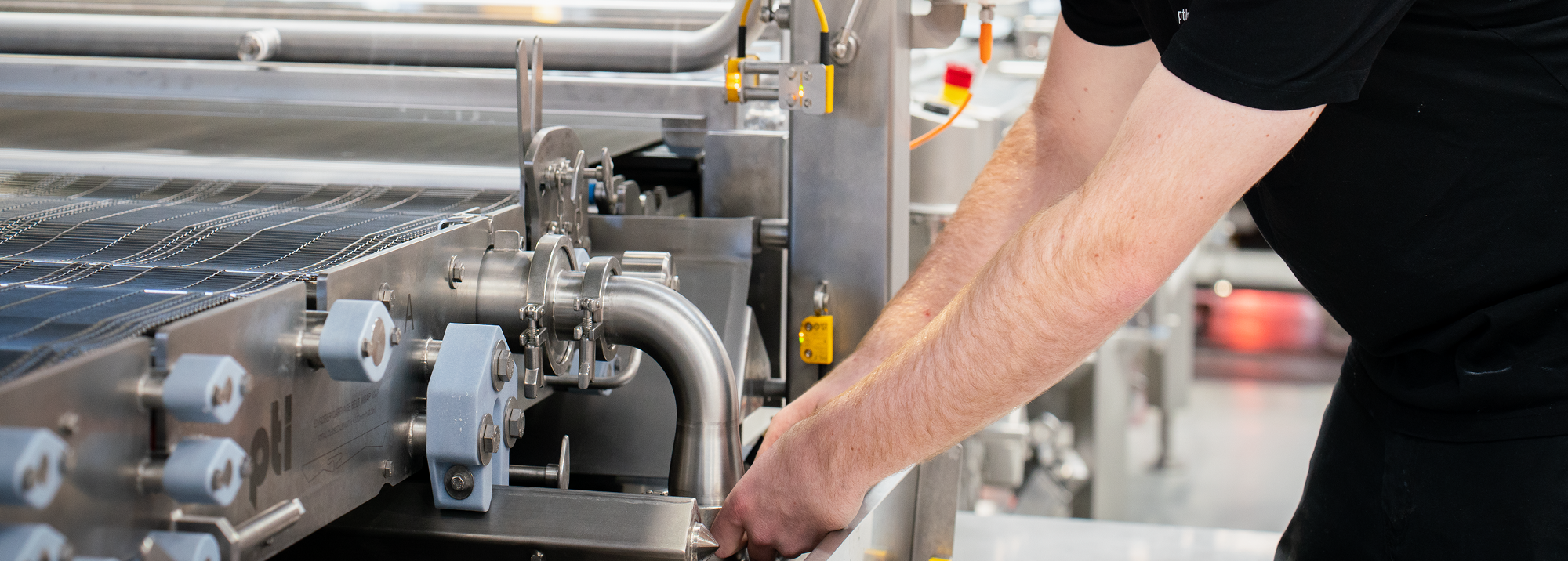The story behind the removable components
It’s so elegantly simple that you have to wonder why no one thought of it before – equipment designed with removable parts that operators could disassemble without using tools.

When it comes to innovation, traditional guidelines don’t apply. Jim Halliday, the founder of PTL, is a prime example of how an unconventional background and a willingness to learn can lead to real improvements. Without the standard engineering degree, Jim drew on his real-world experience with machinery to fix major inefficiencies. Here’s how his creative and adaptable mindset underpinned the ingenious idea of removable components.
Uncleanable machines should be unacceptable
In 1982, Jim became chief engineer at VanCamp chocolate – later purchased by Red Tulip – where he maintained manufacturing equipment. It was here that he first saw the problem he would later set out to solve – uncleanable machines.
“A lot of equipment couldn’t be cleaned – it was horrible. When you did take it to pieces, it would take as long as two or three days and would often be full of bugs – sometimes crawling with the things.”
To make chocolate with nuts, there was always a difficult cleaning regime. But sometimes that wasn’t possible – they’d have to simply label all the products as potentially containing nuts, as they couldn’t guarantee otherwise. Some facilities would avoid including nuts altogether. Jim knew that to make new products, cleaning needed to be easier.
“People would have been horrified if they knew what moldy old products they were eating. It got me thinking that if we could take these things apart, we could actually clean them – like you do your home food processor or mixer.”
The lack of cleanliness was shocking, and this old way of doing things was blocking innovation. Chocolate manufacturers would have to buy and find room for a dozen tanks – one for milk, one for dark, and so on. You could never let them mix because you could never clean them. The only way around it was to maintain separate tanks and lines, meaning smaller players didn’t have the time or money to expand their SKU.
But this was never an option back then. No one was thinking about the problem, let alone the solution. The attitude was, “If it ain’t broke, just leave it full of chocolate – as long as you don’t wash it, it’ll be fine.”
Time to shake things up
When Cadbury bought out Red Tulip in 1989, Jim was made redundant. It was then he decided to do things differently by starting PTL.
“I’d had first-hand experience with the issues that came with limited access to machines. I wanted to solve all those problems with new equipment.”
To help with engineering and innovation, Jim later asked Mike Nevines to join him. Mike had the shared ethos of taking the unconventional approach, and he’s been working at PTL ever since. Here’s what they focused on.
1. Make cleaning so simple that people actually do it
Even with the best intentions, people often put off difficult jobs, thinking they’ll get to them next week or month. Similarly, when people have time pressures, they cut corners.
“As designers, it’s our job to take that out of the equation. We want to make it almost a pleasure to take things to bits so they can be cleaned,” says Jim.
2. Make it easy for a non-engineer
Jim is a fitter by trade, so he always knew how to tinker with things on machines correctly. However, most operators don’t have that expertise. The problem with this? Trying to break apart or adjust a machine when you don’t know what you’re doing can destroy belts and cause all sorts of mechanical damage. “We wanted to create something that could be usable for novices.”
3. Tool-less design, removable components
Mike and Jim could easily imagine what happens on the factory floor and how changes to the machine would change behavior. They were always thinking ahead – how will customers get to that component? How are they going to clean that small piece? And if they can’t, what will the operator do?
The answer: bar and chocolate machines with removable components
It’s so elegantly simple that you have to wonder why no one thought of it before – equipment designed with removable parts that operators could disassemble without using tools. Over the years, ease of use became a philosophy.
“We spent a lot of time making sure our machines were nice and easy to take to pieces,” says Jim.
Here’s how removable components have impacted customers:
- No need for the toolbox when equipment needs cleaning, adjusting, or maintaining
- Protects machinery against damage
- Makes cleaning easier, so people do it more often
Fast-forward to now, and the PTL equipment includes a series of small, clever ideas that contribute to the overall user-friendliness and cleanability of the machines:
- Fool-proof tightening. Built-in stops so operators can tighten everything to the right level.
- No more toolboxes lying around. Adding chains so the T handles can be used quickly and can’t get lost.
- No guesswork. Etched instructions on the sides of the machines to make sure anyone could disassemble and reassemble them.
- No heavy lifting, no damage. The swing-out drive on the melter with internal shaft support prevents it from dropping when the seal is removed.
Listening to customers
These improvements are underpinned by years of listening to customers and staying connected to what is happening on the floor.
“We’ve always traveled to meet customers in the US to talk about what they want. When we understand what they’re doing, we can make their businesses better.”
In an industry where trust and reputation are paramount, PTL lets its machinery do the talking.
Jim says, “Not blowing our trumpet, but we don’t need to chase new customers. The quality gets the word out.”
Want to learn more about PTL’s removable parts? Talk to the team now.